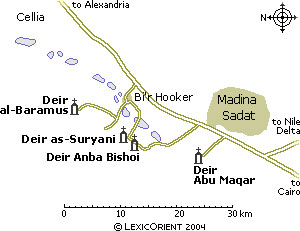Wadi al-Natrun is a narrow, 35km-long valley below sea level west of the Nile Delta. The name al- Natrun (natron) derives from the large quantities of sodium carbonate obtained from a chain of ten salt lakes in the valley. The mineral was used for mummification in ancient Egypt. In the Roman period, it was used for glass manufacture. When the British came to Egypt, they built railroads to transport the salt to Cairo.
In the fourth and fifth centuries many Christians fled from Roman persecution and established hermitages in the valley. Monks first lived in caves, then formed monasteries, most of which now are obscured by sand. The four excavated, restored and active monasteries are Deir Abu Maqar, the monastery of Saint Macarius: Deir al-Baramus; the monastery of the Romans; Deir al-Surian, the monastery of the Syrians; and Deir Anba Bishoi, the monastery of St Bishoi.
The monasteries of Wadi al-Naturn were attacked by Bedouins and Berber tribesmen frequently over the centuries, though the most severe threat to them was the plague and famine in the fourteenth century. As a result of the attacks, high defensive walls became part of the architecture of Wadi al-Natrun's monasteries.
The interiors of the monasteries are all similar, divided into living quarters, churches, kitchens, storage facilities, and a well. There are areas for communion, catechism, and a basin in which sinners are bathed.
Around 1971, Pope Shenouda III took up the restoration of the land and buildings of the area. He purchased new land for cattle breeding and for poultry and dairy production. The monasteries have become well known for the high quality of meat and dairy, and this has allowed the monks to become self-sufficient in their monastic and productive life. The monks also engage in crafts such as textile and glass production.


